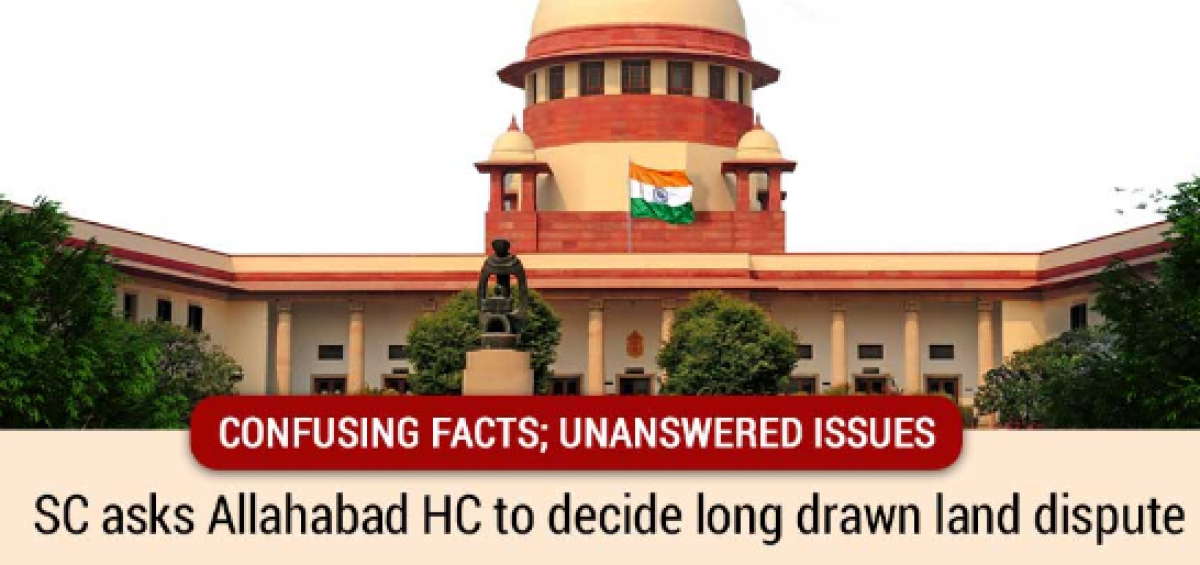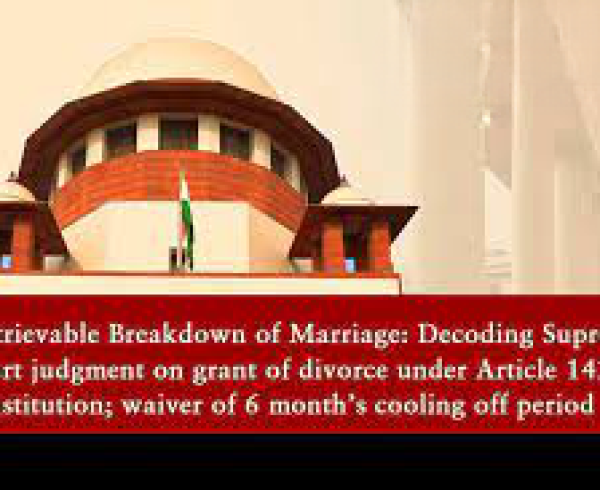The saga of twists and turns in facts of the matter starting with a lease deed, revenue entries, compensation, expunction orders, and what not? The series of developments over the past 100 years of suit land even cautioned the Supreme Court from deciding the matter casually.
Supreme Court: In a batch of Civil Appeals related to a series of litigation related to ownership of land equivalent to 28.56 acres situated in Nainital (‘suit land’) between State and private parties, the Division Bench of Surya Kant and J.K. Maheshwari, JJ. remanded the matter back to the High Court for fresh adjudication due to lack of documents in entirety.
Facts of the Matter
‘A’ obtained a lease of the suit land from colonial rulers on 20-6-1924 (1924 lease deed) for 30 years registered on 22-8-1925 on payment of rent agreed between the parties, also being extendable for another 30 years subject to certain conditions. Revenue entries were made in favour of ‘X’ (also stated to be paternal uncle of respondents), said to have purchased the suit land through sale deed dated 17-11-1947. The 1924 sale deed contained a permission clause reflected in the subsequent sale deed giving vendor the right to sell buildings and constructions after obtaining permit from proper authorities, effecting mutation in favour of vendee on 25-9-1947.
The Court noted that the revenue records continued depicting name of predecessor of respondents as ‘Occupancy Tenant’ on strength of sale deed. At the expiry of 30 years in 1954, predecessor of Respondents applied for renewal and paid enhanced rent as per the 1924 lease deed. Thereafter, consolidation proceedings took place between 1959-1960 while revenue entries remained in the name of Manohar Lal and even compensation was awarded for a portion of Suit Land, which was acquired by the military authorities in 1963.
In 1967, the State filed an eviction suit for possession of suit land with damages before the District Judge. During its pendency, the UP Public Premises (Eviction of Unauthorized Occupants) Act, 1972 (‘1972 Act’) was promulgated and thus, the suit was transferred to the Prescribed Authority under the 1972 Act. Prior to final adjudication before the Prescribed Authority, Bhumidhari certificates were also issued to the predecessor of Respondents by depositing an amount twenty times the land revenue for the Suit Land.
The Prescribed Authority on 25-3-1975 dismissed the suit for non-maintainability in view of the exclusion clause in the 1972 Act wherein the lands held by any class of tenure-holder are exempted from the applicability of the Act. The State’s appeal against the decision of Prescribed Authority before District Judge was also dismissed through order dated 30-7-1976 on grounds of time-bar and non-maintainability.
The Court pointed out that the initial suit of 1967 was never adjudicated on merits on respondents’ claim of tenancy, but on other technical grounds of bar under 1972 Act. However, the order dated 30-7-1976 passed by the District Judge remained unchallenged and thus, after death of the predecessor, mutation proceedings were initiated in 1978 by the respondents based on family settlement. In the absence of relevant orders of mutation, it is stated that the Tahsildar passed order dated 4-7-1978 in favour respondents, further confirmed by order dated 30-8-1978 passed by the SDM directing Tahsildar to mutate suit land in the revenue records. The State appealed against the SDM’s order before the Commissioner, which was rejected through order dated 7-8-1980 and the revision application was also rejected on 31-12-1980. The challenge against these two orders before the Board of Revenue was also dismissed via order dated 20-1-1982 while keeping the issue of ownership unadjudicated.
Since respondents were successful in mutation proceedings, the Pargana Officer accepted partition between the respondents based on family settlement through order dated 30-9-1981.
The District Collector during pendency of revision proceedings before the Board of Revenue in mutation proceedings through order dated 31-12-1981 noted that “on perusal of revenue records, it was found that after the expiry of initial lease period of 30 years, the respondents illegally got themselves recorded as ‘Bhumidhar’ of suit land in revenue records.” and directed expunction/deletion of revenue entries in favour of respondents while recommending initiation of eviction proceedings against them.
The respondents preferred revision before Commissioner against the Expunction order, who passed an interim order dated 20-1-1982 restricting deletion of revenue entries due to pendency of matter before Board of Revenue in mutation proceedings, while the Board of Revenue dismissed pending revision in mutation proceedings on the same date. Despite that, the Tahsildar acted on expunction order and deleted revenue entries which were in favour of respondents. The same was challenged for contempt by respondents before the Allahabad High Court, dismissed in limine on 16-8-1986 after the officials concerned tendered unqualified apologies.
On 16-8-1983, the Commissioner dismissed pending revision against expunction order for maintainability saying that no provision provided for revision of an order passed under the Government Grants Act of 1895 applicable to Uttar Pradesh vide 1960 amendment. The respondents filed a revision against the said decision, which led to Single Member order dated 22-1-1993 setting aside the expunction order saying that the expunction order was passed under the applicable land revenue laws and not the Government Grants Act of 1895, being susceptible to revisionary jurisdiction. Further, neither was any enquiry report obtained nor were the respondents given any opportunity of being heard while passing the expunction order.
The State filed a Writ Petition in 1996 challenging the above order passed by Single Member. Meanwhile, the District Magistrate wrote a letter to the Board of Revenue to seek permission to challenge the Single Member’s order which was followed by the constitution of a Three-Member Bench to scrutinize the said order. The said Bench on 20-12-1996 held that the Single Member’s order lacked jurisdiction and noted that expunction order was passed under the 1895 Act, while justifying the Collector’s expunction order and saying that the suit land automatically resumed in favour of the State after expiry of lease period of 30 years. The respondents filed a second Writ Petition against the said order of Three-Judge Bench in 1997. It was said that a review was filed before Single Member and transferred to the Revenue Court after formation of State of Uttarakhand.
During pendency of writ and Revenue Court proceedings, the District Magistrate passed Restraint Orders dated 2-5-2001 and 21-5-2001 directing the Special Land Acquisition Officer and Tahsildar to restrain the respondents from selling/transferring/mutating the suit land, against which, an injunction suit was filed by the respondents, which was dismissed on 6-6-2002 for non-maintainability. In the revision petition filed by the respondents before Additional Chief Revenue Commissioner, the Restraint Orders were declared void and illegal vide order dated 22-7-2002. It was also noted that the Single Member’s order attained finality and the State recognized respondents’ ownership through longstanding revenue entries and by granting compensation for land acquired by military authorities in 1963. The order dated 22-7-2002 was challenged before the High Court through a Writ Petition.
All three Writ Petitions were heard by the High Court and were decided in favour of respondents through order dated 7-10-2005. On 21-10-2005, the review pending before the Revenue Court was decided in favour of the State by setting aside Single Member’s order and directing compliance with expunction order viewing the Three-Member Bench’s order. In the dismissal of review against the High Court’s decision on 5-8-2006 specifically noted that Expunction Order stood set aside in view of the Single Member’s Order and that order dated 21.10.2005 was passed without any jurisdiction due to prior decision of High Court on 7-10-2005, which was followed by an apology by the Revenue Court citing lack of knowledge of decision of the High Court.
The injunction suit imitated by respondents in 1983 was decreed in favour of respondents by the Trial Court on 20-10-1984, and appeal against the said order was dismissed, and the second appeal followed by review before the High Court was also dismissed.
The land acquisition proceedings were initiated by notification dated 13-4-1982 under Section 4 of the Land Acquisition Act, 1894 for construction of Model Industrial Training Institute including the suit land and respondents were denied compensation saying that the land belonged to the government, due to which, reference was filed by the respondents, which was decided in their favour on 21-2-2006 based on previous appeals holding respondents as lawful owners of the suit land. Appeal against the same was dismissed by the High Court through judgment dated 24-7-2008 while granting compensation in favour of respondents.
Respondents initiated contempt proceedings for violation of order dated 23-2-2007 for maintaining status quo, pointing towards State’s interference with their peaceful possession of the suit land.
Court’s Analysis
The Court noted the different conclusions of the High Court related to the nature of the instrument – sale deed/lease deed, and different stands of respondents being tenure holders accorded the status of ‘Bhumidhar’, and the sale deed for title per se. The Court said that the High Court erred in respect of the nature of instrument, and refused to accept consolidation and acquisition proceedings for validity of revenue entries which became the basis of compensation to respondents for suit land.
The Court brought up the settled law regarding natural/ ordinary meaning to interpretation of contractual term in the case of M.O.H. Uduman v. M.O.H. Aslum, (1991) 1 SCC 412. The Court opined that “a reasoned finding on both the nature of Sale Deed as well as whether the same was violative of conditions of the 1924 Lease Deed goes to the heart of the present dispute.” The Court went into the legislative history of the term ‘Occupancy Tenants’ and accordingly commented that “the predecessor of respondents could not have been accorded the status of ‘Sirdar’ under the Zamindari Notification on the strength of revenue entries which recorded him as an ‘Occupancy Tenant’.”
The Court refrained from deciding ownership rights of the suit land casually and remanded the appeals back to the High Court for effective adjudication on merits. The change in ownership of certain portions of the suit land due to subsequent sale by the respondents further tied the Court’s hands, as expressed in the instant matter. Since a decision after all these years of litigation cannot be based on conjectures and surmises or mere guesswork, the Court sought entirety of documents showcasing creation of ownership or possessory rights regarding suit land, before adjudicating the matter.
The Court explained its’ stance that “There are indeed compelling circumstances which have been left unanswered by the courts below, because of which determination of several factual issues have been left in limbo.”
Keeping regard with the long-drawn pendency of disputes surrounding the suit land, the Court directed High Court to take up the instant matter at the earliest and preferably dispose of the same within 12 months. The Court also directed the State to produce the records and notifications in entirety before the High Court. The Court set aside the High Court’s judgments and remanded the matter back for fresh adjudication.
[State of Uttarakhand v. Ravi Kumar, 2023 SCC OnLine SC 655, Judgment dated 18-5-2023].






Leave a Comment